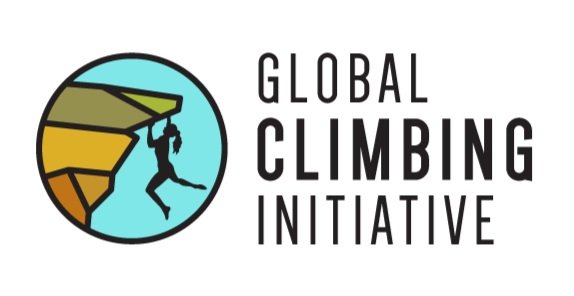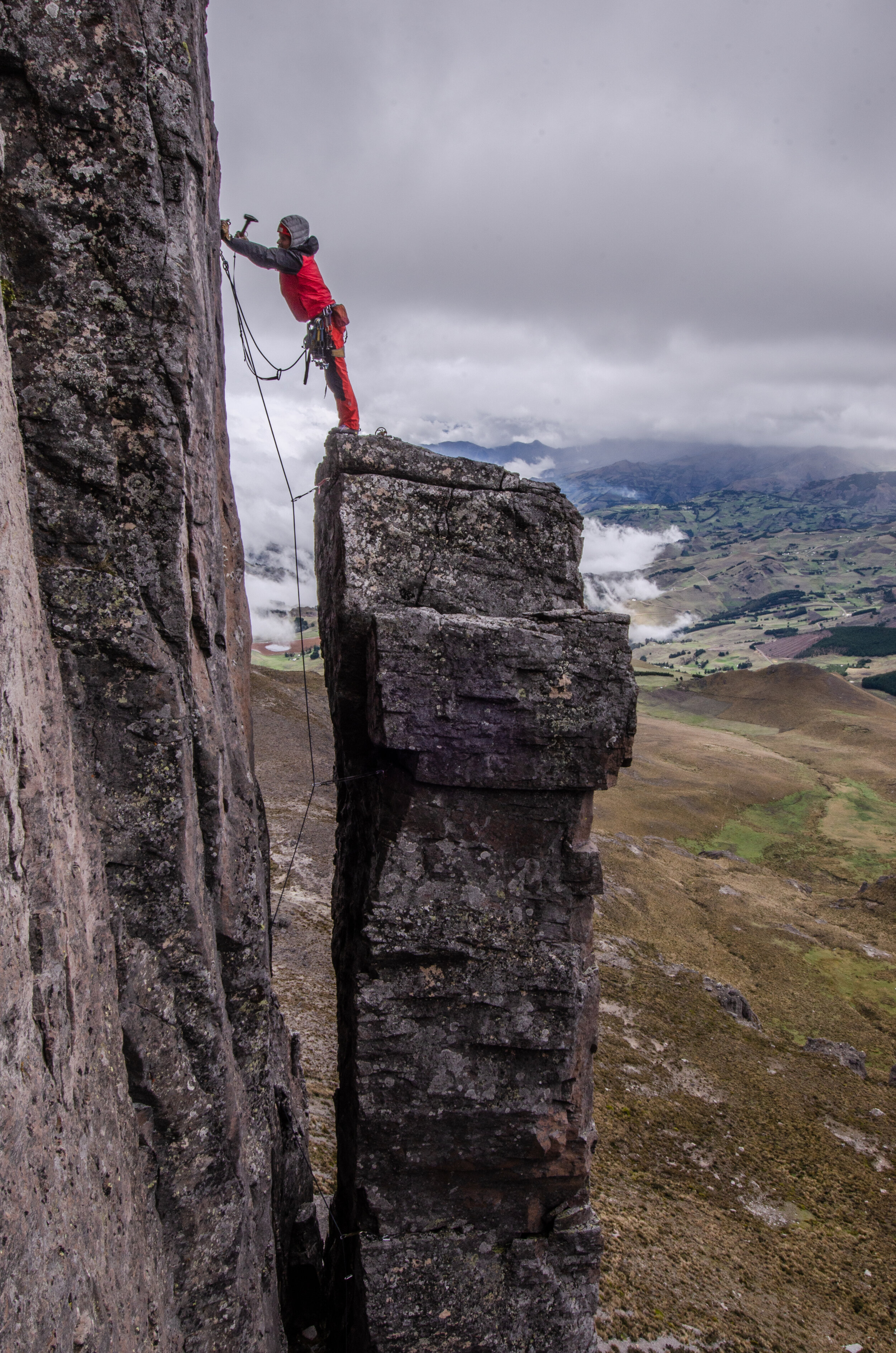Climbing in the Country of Four Worlds
How one organization is using climbing to elevate rural Ecuador
By Nicki Simon | November 17, 2020
Developing routes in the Columns of Tangan. Photo by Nicolas Davalos.
Tucked between Colombia, Peru, and over 1,200 miles of coastline lies a small country often called the country of four worlds. With four distinct geographic regions including the Pacific coastal region, the Andes mountain range, the Amazon jungle, and the Galapagos Islands, Ecuador is a truly unique and enticing place. The access to incredible peaks and high altitude volcanoes has propelled Ecuador to become a top destination for mountaineering. Although this has been the case for decades, climbing development only started in the last 25 years. Since the late 1990s, when the first routes in Ecuador were bolted, climbing has grown rapidly. There are now 38 established climbing areas throughout the country, comprising hundreds of routes.
Rock climbing in the Columns of Tangan-route Sanacion 5.12b. Photo by Nicolas Davalos.
It has been proven time and again around the world that tourism from climbing and other mountain sports can be a powerful mechanism for creating sustainable economic development. With so much potential for these activities, Ecuador could become a prime example. Local climbers began to realize this, and in 2018 Fundación Acceso Andino (FAA), or the Andean Access Fund, was established to develop eco-tourism and address needs such as land conservation, rebolting, and access to climbing areas. Felipe Proano, President of FAA and author of the Ecuador guidebook, believes climbing and other mountain sports can transform many rural regions of Ecuador. Throughout the country, people are affected by prominent stresses including lack of access to education, healthcare, and economic opportunity. The integration of tourism into the economy could drastically help alleviate some of these issues. Unfortunately, as is the case in many countries, the Ecuadorian government does not currently recognize outdoor climbing as a sport. Subsequently, it does not provide backing for development projects, despite its potential for social and economic growth within the country.
Base camp at night, Simiatug. Photo by Nicolas Davalos.
With financial support from the private sector, Proano and his team at Fundación Acceso Andino have begun projects to introduce tourism into rural areas, emphasizing climbing development and the social and economic impacts it can have in a community. Right now, their primary focus is on one of the most recently discovered climbing areas located just outside a small town in the Bolivar province called Simiatug, meaning “mouth of the wolf” in the local language (Quechua/Kichwa). This ancestral town has a nearly entirely indigenous population, dating back to pre-Hispanic times. Although the area offers excellent geographical and weather conditions for tourism, it has long been ignored by the government. Therefore, it is missing out on exposure to the industrial and touristic development that other parts of the country are experiencing. The people of Simiatug are very isolated and remain largely dependent on agriculture for their livelihood. FAA, however, is working to give them greater access to opportunity.
On the top of the broken pillar, Simiatug. Photo by Nicolas Davalos.
The nearby eroded caldera, known now as the Towers of Simiatug, holds seemingly endless potential for climbing among its impressive basalt and andesite columns, sitting at a staggering 14,000 feet above sea level. The area also provides phenomenal opportunity for other mountain sports such as mountain biking, trekking, horseback riding, and more. So far, there are 53 established routes in Simiatug ranging from one to six pitches. Still, over 100 potential lines have been counted, just waiting to be cleaned and climbed. FAA has a long-term vision of opening a refugio, or mountain shelter, for climbers and visitors around Simiatug. Proano envisions a future for the people of Simiatug where they have a sustainable and diversified economy, utilizing multiple facets of the tourism potential. “The interaction of the local inhabitants into modern mountain sports is a key element. This can be achieved by hiring the services of the local community to shuttle gear by animals such as horses, mules, and llamas, and by acquiring basic services from them such as local Andean food. In the future, with the introduction of tourism and education, future generations in Simiatug can offer their own guiding services on the surrounding highlands.”
Manuel Talahua and his horse, Estrellita. Manuel offers gear shuttling services to base camp. Photo by Nicolas Davalos.
With projects like this, there is always concern over the displacement of a culture as tourism increases. FAA recognizes the importance of preserving the local identity and heritage in the rural communities they interact with, and works to ensure their projects are not harmful in this capacity. The first step of the project in Simiatug was to build a relationship with the local community and ask if they wanted to pursue this opportunity for development, which was answered with a resounding “yes.” Javier Arizaga, Vice President of FAA, explains how developing an adventure tourism sector will promote the continuance of these important ancestral traditions. "It is a fact that globalization and global commerce are affecting local culture, thus causing communities to forget their traditions and manufacturing of local products. We believe that through tourism, we can empower local communities to find the aggregate value of their local products, their local cuisine, as well as their traditional art and fashion, through touristic commerce.”
Cleaning sessions from Strange and Eternal 5.10 on Warmi (female) Torre, Simiatug. Photo by Nicolas Davalos.
Although Fundación Acceso Andino has done a fair amount of work in the area already, there are many obstacles ahead of them to continue the project. For the most part, these obstacles boil down to government corruption and political instability, and the onset of the COVID-19 pandemic. “The tourism secretary has promoted commercial destinations for years, but lacked the creation of new destinations, especially in indigenous lands,” Proano explains. “FAA has reached out countless times for public ways of financing, but has failed to obtain any attention. Also, Ecuador is a broken nation, meaning the state spends more money than it produces.” Proano does note that the private sector has been the most helpful in funding this project, specifically Banco del Pichincha and Sabaibeer S.A. As if things weren’t already complicated, COVID took it to another level. “We have lost 70% or more of the planned annual budget and it's been virtually impossible to obtain new ways of financing. Also, due to fear of contracting the virus, the indigenous people from Simiatug have isolated themselves even more,” said Proano. The team quickly worked to develop new COVID protocols, but without recovering their lost funds, the project is in jeopardy of being postponed or even abandoned.
Manuel and Luis, FAA’s local indigenous friends from Cocha Colorada community, Simiatug. Photo by Nicolas Davalos.
To help the people of Simiatug capitalize on the incredible mountains surrounding them and create more sustainable livelihoods through tourism, Fundación Acceso Andino needs all the support they can get. From gear and equipment donations, to sponsorships, to summer internships, to merely spreading the word, anything helps boost their progress on this project. “A way to upgrade ourselves is to help upgrade the lives of others,” said Proano. By supporting FAA’s work, our global climbing community can make a difference and see this incredible destination take hold.
Visit http://fondoaccesoandino.org/ to learn more about climbing development in Ecuador, and if you are interested in contributing to the work of Fundacion Acceso Andino and saving the project in Simiatug, please email fondoaccesoandino@gmail.com or visit http://fondoaccesoandino.org/donaciones/.







